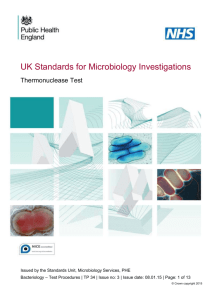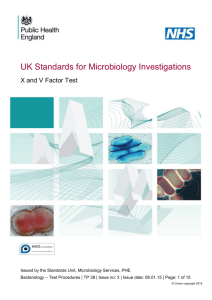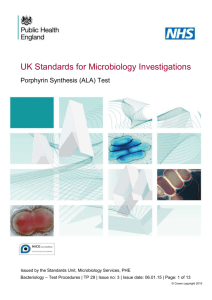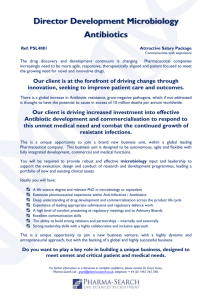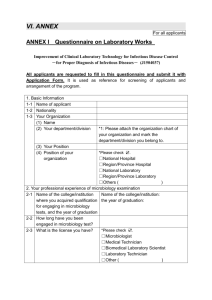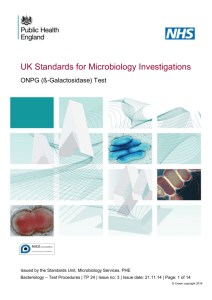TP 27i3 January 2015: issued
advertisement
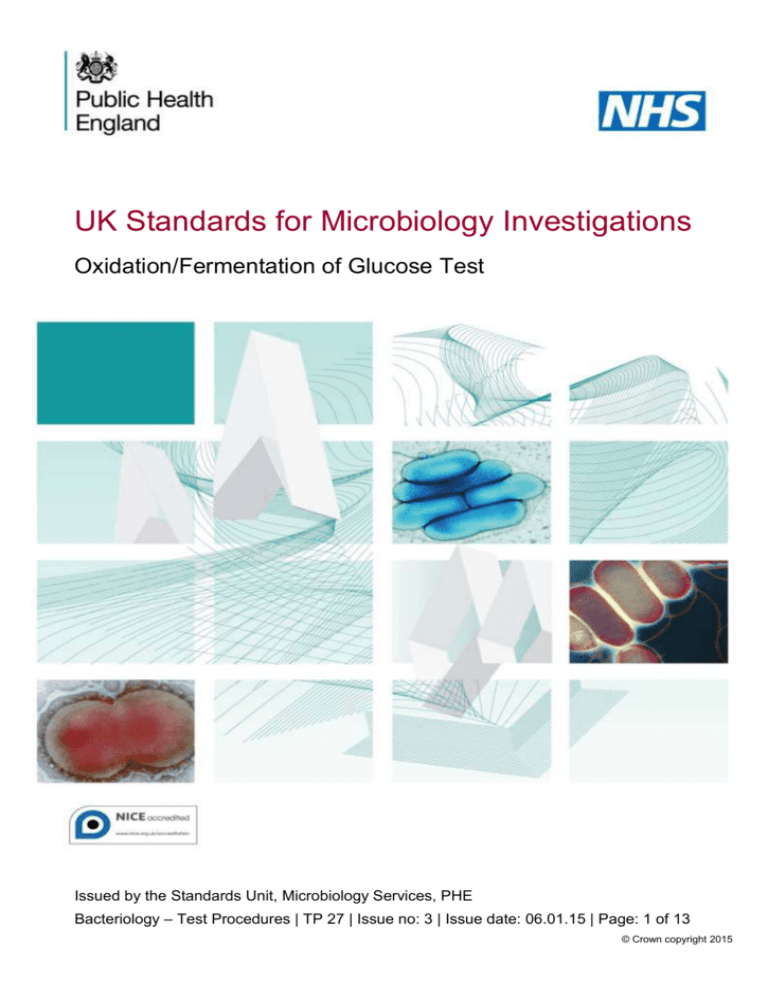
UK Standards for Microbiology Investigations Oxidation/Fermentation of Glucose Test Issued by the Standards Unit, Microbiology Services, PHE Bacteriology – Test Procedures | TP 27 | Issue no: 3 | Issue date: 06.01.15 | Page: 1 of 13 © Crown copyright 2015 Oxidation/Fermentation of Glucose Test Acknowledgments UK Standards for Microbiology Investigations (SMIs) are developed under the auspices of Public Health England (PHE) working in partnership with the National Health Service (NHS), Public Health Wales and with the professional organisations whose logos are displayed below and listed on the website https://www.gov.uk/ukstandards-for-microbiology-investigations-smi-quality-and-consistency-in-clinicallaboratories. SMIs are developed, reviewed and revised by various working groups which are overseen by a steering committee (see https://www.gov.uk/government/groups/standards-for-microbiology-investigationssteering-committee). The contributions of many individuals in clinical, specialist and reference laboratories who have provided information and comments during the development of this document are acknowledged. We are grateful to the Medical Editors for editing the medical content. For further information please contact us at: Standards Unit Microbiology Services Public Health England 61 Colindale Avenue London NW9 5EQ E-mail: standards@phe.gov.uk Website: https://www.gov.uk/uk-standards-for-microbiology-investigations-smi-qualityand-consistency-in-clinical-laboratories UK Standards for Microbiology Investigations are produced in association with: Logos correct at time of publishing. Bacteriology – Test Procedures | TP 27 | Issue no: 3 | Issue date: 06.01.15 | Page: 2 of 13 UK Standards for Microbiology Investigations | Issued by the Standards Unit, Public Health England Oxidation/Fermentation of Glucose Test Contents ACKNOWLEDGMENTS .......................................................................................................... 2 CONTENTS ............................................................................................................................. 3 AMENDMENT TABLE ............................................................................................................. 4 UK STANDARDS FOR MICROBIOLOGY INVESTIGATIONS: SCOPE AND PURPOSE ....... 5 SCOPE OF DOCUMENT ......................................................................................................... 8 INTRODUCTION ..................................................................................................................... 8 TECHNICAL INFORMATION/LIMITATIONS ........................................................................... 8 1 SAFETY CONSIDERATIONS ...................................................................................... 9 2 REAGENTS AND EQUIPMENT ................................................................................... 9 3 QUALITY CONTROL ORGANISMS ............................................................................ 9 4 PROCEDURE AND RESULTS..................................................................................... 9 APPENDIX: OXIDATION/FERMENTATION OF GLUCOSE TEST ....................................... 11 REFERENCES ...................................................................................................................... 12 Bacteriology – Test Procedures | TP 27 | Issue no: 3 | Issue date: 06.01.15 | Page: 3 of 13 UK Standards for Microbiology Investigations | Issued by the Standards Unit, Public Health England Oxidation/Fermentation of Glucose Test Amendment Table Each SMI method has an individual record of amendments. The current amendments are listed on this page. The amendment history is available from standards@phe.gov.uk. New or revised documents should be controlled within the laboratory in accordance with the local quality management system. Amendment No/Date. 5/06.01.15 Issue no. discarded. 2.3 Insert Issue no. 3 Section(s) involved Amendment Whole document. Hyperlinks updated to gov.uk. Page 2. Updated logos added. Scope of the document. The scope has been updated with information and referenced. Introduction. This section has been updated and referenced. Technical information/Limitations. This section has been updated and references added. Safety Considerations. References updated. Reagents/Equipment. References added. Quality Control Organisms. The positive controls for the Gram positive cocci have been amended; Micrococcus luteus NCTC 4351 to Micrococcus luteus NCTC 2665, Staphylococcus aureus NCTC 8532 to Staphylococcus aureus NCTC 6571. All the NCTC strains in this test have been validated by NCTC. Procedures and Results. This section has been updated and references added. Flowchart. This flowchart has been amended and updated for easy guidance. References. Some references updated. Bacteriology – Test Procedures | TP 27 | Issue no: 3 | Issue date: 06.01.15 | Page: 4 of 13 UK Standards for Microbiology Investigations | Issued by the Standards Unit, Public Health England Oxidation/Fermentation of Glucose Test UK Standards for Microbiology Investigations: Scope and Purpose Users of SMIs SMIs are primarily intended as a general resource for practising professionals operating in the field of laboratory medicine and infection specialties in the UK. SMIs provide clinicians with information about the available test repertoire and the standard of laboratory services they should expect for the investigation of infection in their patients, as well as providing information that aids the electronic ordering of appropriate tests. SMIs provide commissioners of healthcare services with the appropriateness and standard of microbiology investigations they should be seeking as part of the clinical and public health care package for their population. Background to SMIs SMIs comprise a collection of recommended algorithms and procedures covering all stages of the investigative process in microbiology from the pre-analytical (clinical syndrome) stage to the analytical (laboratory testing) and post analytical (result interpretation and reporting) stages. Syndromic algorithms are supported by more detailed documents containing advice on the investigation of specific diseases and infections. Guidance notes cover the clinical background, differential diagnosis, and appropriate investigation of particular clinical conditions. Quality guidance notes describe laboratory processes which underpin quality, for example assay validation. Standardisation of the diagnostic process through the application of SMIs helps to assure the equivalence of investigation strategies in different laboratories across the UK and is essential for public health surveillance, research and development activities. Equal Partnership Working SMIs are developed in equal partnership with PHE, NHS, Royal College of Pathologists and professional societies. The list of participating societies may be found at https://www.gov.uk/uk-standards-formicrobiology-investigations-smi-quality-and-consistency-in-clinical-laboratories. Inclusion of a logo in an SMI indicates participation of the society in equal partnership and support for the objectives and process of preparing SMIs. Nominees of professional societies are members of the Steering Committee and Working Groups which develop SMIs. The views of nominees cannot be rigorously representative of the members of their nominating organisations nor the corporate views of their organisations. Nominees act as a conduit for two way reporting and dialogue. Representative views are sought through the consultation process. SMIs are developed, reviewed and updated through a wide consultation process. Microbiology is used as a generic term to include the two GMC-recognised specialties of Medical Microbiology (which includes Bacteriology, Mycology and Parasitology) and Medical Virology. Bacteriology – Test Procedures | TP 27 | Issue no: 3 | Issue date: 06.01.15 | Page: 5 of 13 UK Standards for Microbiology Investigations | Issued by the Standards Unit, Public Health England Oxidation/Fermentation of Glucose Test Quality Assurance NICE has accredited the process used by the SMI Working Groups to produce SMIs. The accreditation is applicable to all guidance produced since October 2009. The process for the development of SMIs is certified to ISO 9001:2008. SMIs represent a good standard of practice to which all clinical and public health microbiology laboratories in the UK are expected to work. SMIs are NICE accredited and represent neither minimum standards of practice nor the highest level of complex laboratory investigation possible. In using SMIs, laboratories should take account of local requirements and undertake additional investigations where appropriate. SMIs help laboratories to meet accreditation requirements by promoting high quality practices which are auditable. SMIs also provide a reference point for method development. The performance of SMIs depends on competent staff and appropriate quality reagents and equipment. Laboratories should ensure that all commercial and in-house tests have been validated and shown to be fit for purpose. Laboratories should participate in external quality assessment schemes and undertake relevant internal quality control procedures. Patient and Public Involvement The SMI Working Groups are committed to patient and public involvement in the development of SMIs. By involving the public, health professionals, scientists and voluntary organisations the resulting SMI will be robust and meet the needs of the user. An opportunity is given to members of the public to contribute to consultations through our open access website. Information Governance and Equality PHE is a Caldicott compliant organisation. It seeks to take every possible precaution to prevent unauthorised disclosure of patient details and to ensure that patient-related records are kept under secure conditions. The development of SMIs are subject to PHE Equality objectives https://www.gov.uk/government/organisations/public-health-england/about/equalityand-diversity. The SMI Working Groups are committed to achieving the equality objectives by effective consultation with members of the public, partners, stakeholders and specialist interest groups. Legal Statement Whilst every care has been taken in the preparation of SMIs, PHE and any supporting organisation, shall, to the greatest extent possible under any applicable law, exclude liability for all losses, costs, claims, damages or expenses arising out of or connected with the use of an SMI or any information contained therein. If alterations are made to an SMI, it must be made clear where and by whom such changes have been made. The evidence base and microbial taxonomy for the SMI is as complete as possible at the time of issue. Any omissions and new material will be considered at the next review. These standards can only be superseded by revisions of the standard, legislative action, or by NICE accredited guidance. SMIs are Crown copyright which should be acknowledged where appropriate. Bacteriology – Test Procedures | TP 27 | Issue no: 3 | Issue date: 06.01.15 | Page: 6 of 13 UK Standards for Microbiology Investigations | Issued by the Standards Unit, Public Health England Oxidation/Fermentation of Glucose Test Suggested Citation for this Document Public Health England. (2015). Oxidation/Fermentation of Glucose Test. UK Standards for Microbiology Investigations. TP 27 Issue 3. https://www.gov.uk/ukstandards-for-microbiology-investigations-smi-quality-and-consistency-in-clinicallaboratories Bacteriology – Test Procedures | TP 27 | Issue no: 3 | Issue date: 06.01.15 | Page: 7 of 13 UK Standards for Microbiology Investigations | Issued by the Standards Unit, Public Health England Oxidation/Fermentation of Glucose Test Scope of Document Bacteria utilise glucose and other carbohydrates through various metabolic pathways. Some are oxidative routes but others involve fermentation reactions. The oxidationfermentation test, also known as the “oxferm”/ OF test, is used to determine which route is used1. The test is used to differentiate between species, particularly Gram negative rods as well as between genera Staphylococcus and Micrococcus. This SMI should be used in conjunction with other SMIs. Introduction The oxidative-fermentative test is used to determine if bacteria metabolise carbohydrates oxidatively, by fermentation, or are non-saccharolytic and therefore have no ability to use the carbohydrate in the media. Oxidative organisms can only metabolise glucose or other carbohydrates under aerobic conditions ie oxygen is the ultimate hydrogen acceptor. Other organisms ferment glucose and the hydrogen acceptor is then another substance eg sulphur. This fermentative process is independent of oxygen and cultures of organisms may be aerobic or anaerobic. The end product of metabolising a carbohydrate is an acid. The method described, sometimes referred to as the Hugh and Leifson test employs a semi-solid medium in tubes containing the carbohydrate under test (usually glucose) and a pH indicator2. Two tubes are inoculated and one is sealed immediately to produce anaerobic conditions. The Enterobacteriaceae, produce an acid reaction throughout the medium in both tubes. Organisms that cannot break down the carbohydrate aerobically or anaerobically, eg Alcaligenes faecalis, produce an alkaline reaction in the open tube and no change in the covered tube. Hugh and Leifson’s medium can also be used for recording gas production and motility3. Staphylococci and micrococci are tested with the Baird-Parker modification of the medium1. Technical Information/Limitations All identification tests should be performed, where possible, from a non-selective medium. If the test is performed from selective agar, a purity plate must be included to check for purity of the organism. If screw cap tubes are used, they should not be closed too tightly to permit air exchange4. Some organisms are unable to grow in Hugh and Leifson’s medium. In this instance, repeat the test after enriching each tube with 2% serum or 0.1% yeast extract 3. Prolonged incubation may be required by some organisms before acid production is visible3. The delayed reaction is attributed to inability of a carbohydrate to penetrate the bacterial cell5. The colour change produced by oxidative organisms start at the surface of the medium. It may not be apparent for several days. Care must be taken not to mistake this for a negative reaction6. Mineral oil is not recommended for use because it is a heavy liquid petroleum and therefore increases air diffusion6. Bacteriology – Test Procedures | TP 27 | Issue no: 3 | Issue date: 06.01.15 | Page: 8 of 13 UK Standards for Microbiology Investigations | Issued by the Standards Unit, Public Health England Oxidation/Fermentation of Glucose Test Safety Considerations7-23 1 Refer to current guidance on the safe handling of all organisms and reagents documented in this UK Standard for Microbiology Investigation. All work likely to generate aerosols must be performed in a microbiological safety cabinet. The above guidance should be supplemented with local COSHH and risk assessments. Compliance with postal and transport regulations is essential. 2 Reagents and Equipment Discrete bacterial colonies growing on solid medium Two different media are used depending on the organism under test. - Staphylococci and micrococci require Baird Parker’s modification of the OF medium1 - Gram negative rods require Hugh and Leifson’s OF basal medium 6 Bacteriological straight wire/loop or disposable alternative Soft Paraffin Oil Quality Control Organisms6 3 Gram negative rods Positive control Negative control Oxidation Pseudomonas aeruginosa NCTC 10662 Fermentation Escherichia coli NCTC 10418 No action Acinetobacter Iwoffii NCTC 5866 Gram positive cocci Positive control Negative control Oxidation Micrococcus luteus NCTC 2665 Fermentation Staphylococcus aureus NCTC 6571 No action OF basal medium without carbohydrate - Note: Quality control should be carried out on every batch of medium. 4 Procedure and Results1-3,6 4.1 Oxidation Fermentation Test Method Heat 2 tubes of medium in boiling water for 10 minutes to remove the oxygen and allow cooling before use Stab-inoculate both tubes by inserting a straight wire vertically to approximately ¼ inch from the bottom Bacteriology – Test Procedures | TP 27 | Issue no: 3 | Issue date: 06.01.15 | Page: 9 of 13 UK Standards for Microbiology Investigations | Issued by the Standards Unit, Public Health England Oxidation/Fermentation of Glucose Test Incubate one tube aerobically and either incubate the second tube anaerobically or seal the surface with a layer of melted soft paraffin to a depth of about 3cm above the medium to create anaerobic conditions. Set up the controls alongside the test organism Incubate at 35°C for 48hr or longer. Longer incubation may be required for slowly growing species Examine tubes daily for colour change Interpretation Gram negative rod reactions Positive result Oxidation Acid in aerobic tube only (yellow colour in aerobic tube, green in anaerobic tube) Fermentation Acid in both tubes (yellow colour) Negative result (Neither fermentation nor oxidation) No acid production (blue or green colour in aerobic tube, green in anaerobic tube) Gram positive cocci reactions Positive result Oxidation Acid in aerobic tube only (yellow colour in aerobic tube, purple in anaerobic tube) Fermentation Acid in both tubes (yellow colour) Negative result (Neither fermentation nor oxidation) No acid production /No colour change (purple colour in both tubes) Note: The semisolid consistency of the medium also allows for detection of motility. Hazy growth away from the stab line can also be noted. Bacteriology – Test Procedures | TP 27 | Issue no: 3 | Issue date: 06.01.15 | Page: 10 of 13 UK Standards for Microbiology Investigations | Issued by the Standards Unit, Public Health England Oxidation/Fermentation of Glucose Test Appendix: Oxidation/Fermentation of Glucose Test Isolate discrete colony Heat two tubes of medium in boiling water for 10 min to drive off the oxygen and cool Inoculate by stabbing with a straight wire Incubate at 35°C for 48hr or longer: Tube 1 – aerobically Tube 2 - anaerobically (or seal the surface with a layer of soft paraffin oil) Oxidation Fermentation Neither fermentation nor oxidation Acid in Tube 1 only Acid in both tubes No acid production Tube 1 = yellow colour Tube 2 = green colour Tube 1 = yellow colour Tube 2 = purple colour Both tubes = yellow colour Tube 1 = blue or green colour Tube 2 = green colour Both tubes = purple colour Gram negative rod reaction Gram positive cocci reaction Both Gram negative rod and Gram positive cocci reactions Gram negative rod reaction Gram positive cocci reaction This flowchart is for guidance only. Bacteriology – Test Procedures | TP 27 | Issue no: 3 | Issue date: 06.01.15 | Page: 11 of 13 UK Standards for Microbiology Investigations | Issued by the Standards Unit, Public Health England Oxidation/Fermentation of Glucose Test References 1. Collins CH, Lyne PM, Grange JM, Falkinham JO. Identification methods. In: Collins CH, Lyne PM, Grange JM, Falkinham JO, editors. Collins and Lyne's Microbiological Methods. 8th ed. Arnold; 2004. p. 89-109. 2. Hugh R, LEIFSON E. The taxonomic significance of fermentative versus oxidative metabolism of carbohydrates by various gram negative bacteria. J Bacteriol 1953;66:24-6. 3. Barrow GI, Feltham RKA. Bacterial characters and characterization. Cowan and Steel's Manual for the Identification of Medical Bacteria. 3rd ed. Cambridge: Cambridge University Press; 1999. p. 2145, 224-5. 4. Hanson,A. Oxidative-Fermentative test protocol. American Society for Microbiology. 5. LEDERBERG J. The beta-d-galactosidase of Escherichia coli, strain K-12. J Bacteriol 1950;60:38192. 6. MacFaddin JF. Oxidation- Fermentation Test. Biochemical Tests for Identification of Medical Bacteria. 3rd ed. Philadelphia: Lippincott Wilkins and Williams; 2000. p. 379-87. 7. European Parliament. UK Standards for Microbiology Investigations (SMIs) use the term "CE marked leak proof container" to describe containers bearing the CE marking used for the collection and transport of clinical specimens. The requirements for specimen containers are given in the EU in vitro Diagnostic Medical Devices Directive (98/79/EC Annex 1 B 2.1) which states: "The design must allow easy handling and, where necessary, reduce as far as possible contamination of, and leakage from, the device during use and, in the case of specimen receptacles, the risk of contamination of the specimen. The manufacturing processes must be appropriate for these purposes". 8. Official Journal of the European Communities. Directive 98/79/EC of the European Parliament and of the Council of 27 October 1998 on in vitro diagnostic medical devices. 7-12-1998. p. 1-37. 9. Health and Safety Executive. Safe use of pneumatic air tube transport systems for pathology specimens. 9/99. 10. Department for transport. Transport of Infectious Substances, 2011 Revision 5. 2011. 11. World Health Organization. Guidance on regulations for the Transport of Infectious Substances 2013-2014. 2012. 12. Home Office. Anti-terrorism, Crime and Security Act. 2001 (as amended). 13. Advisory Committee on Dangerous Pathogens. The Approved List of Biological Agents. Health and Safety Executive. 2013. p. 1-32 14. Advisory Committee on Dangerous Pathogens. Infections at work: Controlling the risks. Her Majesty's Stationery Office. 2003. 15. Advisory Committee on Dangerous Pathogens. Biological agents: Managing the risks in laboratories and healthcare premises. Health and Safety Executive. 2005. 16. Advisory Committee on Dangerous Pathogens. Biological Agents: Managing the Risks in Laboratories and Healthcare Premises. Appendix 1.2 Transport of Infectious Substances Revision. Health and Safety Executive. 2008. Bacteriology – Test Procedures | TP 27 | Issue no: 3 | Issue date: 06.01.15 | Page: 12 of 13 UK Standards for Microbiology Investigations | Issued by the Standards Unit, Public Health England Oxidation/Fermentation of Glucose Test 17. Centers for Disease Control and Prevention. Guidelines for Safe Work Practices in Human and Animal Medical Diagnostic Laboratories. MMWR Surveill Summ 2012;61:1-102. 18. Health and Safety Executive. Control of Substances Hazardous to Health Regulations. The Control of Substances Hazardous to Health Regulations 2002. 5th ed. HSE Books; 2002. 19. Health and Safety Executive. Five Steps to Risk Assessment: A Step by Step Guide to a Safer and Healthier Workplace. HSE Books. 2002. 20. Health and Safety Executive. A Guide to Risk Assessment Requirements: Common Provisions in Health and Safety Law. HSE Books. 2002. 21. Health Services Advisory Committee. Safe Working and the Prevention of Infection in Clinical Laboratories and Similar Facilities. HSE Books. 2003. 22. British Standards Institution (BSI). BS EN12469 - Biotechnology - performance criteria for microbiological safety cabinets. 2000. 23. British Standards Institution (BSI). BS 5726:2005 - Microbiological safety cabinets. Information to be supplied by the purchaser and to the vendor and to the installer, and siting and use of cabinets. Recommendations and guidance. 24-3-2005. p. 1-14 Bacteriology – Test Procedures | TP 27 | Issue no: 3 | Issue date: 06.01.15 | Page: 13 of 13 UK Standards for Microbiology Investigations | Issued by the Standards Unit, Public Health England
